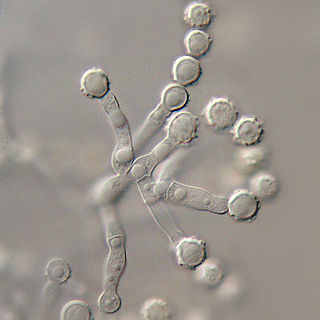
Neurospora is a genus of Ascomycete fungi. The genus name, meaning "nerve spore" refers to the characteristic striations on the spores that resemble axons.

The order Sordariales is one of the most diverse taxonomic groups within the Sordariomycetes.

Microascus is a genus of fungi in the family Microascaceae.
Lophotrichus is a genus of fungi in the family Microascaceae.
Selinia is a genus of fungi in the class Sordariomycetes. It consisted of two species in 2008, and had 5 species in 2023.
Neoscytalidium is a genus of fungi in the Botryosphaeriaceae family.
Delitschia is a genus of fungi in the family Delitschiaceae.

Trichobolus is a genus of fungi in the Thelebolaceae family.
Cercophora is a genus of fungi which was within the Lasiosphaeriaceae family. As of 2020, it was placed into the Neoschizotheciaceae family.

Podospora is a genus of fungi in the family Podosporaceae. Fossils of Podospora have been reported from 12 million year old rocks from central England.
Triangularia is a genus of fungi in the family Podosporaceae.
Zopfiella is a genus of fungi within the Lasiosphaeriaceae family.
Thielavia is a genus of fungi in the family Chaetomiaceae. Circumscribed by German botanist Friedrich Wilhelm Zopf in 1876, Thielavia is a teleomorph of Myceliophthora. Collectively, the genus is widely distributed, and according to a 2008 estimate, contained 31 species. Thielavia heterothallica and T. terrestris can cause infections in humans.
The Ceratostomataceae are a family of fungi in the phylum Ascomycota, class Sordariomycetes, subclass Hypocreomycetidae and order Coronophorales.
Sphaerodes is a genus of fungi within the Coronophorales order but it has not been placed within a family.
Klasterskya is a genus of fungi in the family Ophiostomataceae.
Preussia is a genus of fungi in the family Sporormiaceae. The widespread genus contains 51 species that grow on dung or in the soil.
The Cainiaceae are a family of (previously) two genera of fungi in the order Xylariales. The family was circumscribed by John C. Krug in 1979.

Bertia is a genus of fungi within the Bertiaceae family, and Hypocreomycetidae subclass.

The Coniochaeta are a genus of pleomorphic yeasts of the order Coniochaetales and are pathogens of trees. Some species have also been found to form endophytic associations within plants in which they live inside plant tissues but do not actually harm the organism. They can take the form of pink to brown colonies, hyphae, conidiophores or sclerotia. In 2013, the Lecythophora were merged with the Coniochaeta, following suggestions by Ziauddin Khan et al.






